Biology > QUESTIONS & ANSWERS > An Advanced Review of SLP Complete Q&A 2021/2022. (All)
An Advanced Review of SLP Complete Q&A 2021/2022.
Document Content and Description Below
An Advanced Review of SLP Complete Q&A 2021/2022. Respiration relies on the muscles of inspiration and expiration. The thick, dome-shaped muscle that separates the abdomen from the thorax is call... ed the ANS- diaphragm Most pharyngeal muscles are innervated by these cranial nerves: ANS- IX (Glossopharyngeal) X (Vagus) The primary muscle of the lips is the ANS- orbicularis oris The neurons that transmit information away from the brain are called ANS- efferent neurons An important structure adjacent to the brainstem that contains the hypothalamus (which controls emotions) and the thalamus (which relays sensory impulses to various portions of the cerebral cortex) is called the ANS- diencephalon The corpus striatum is composed of three nuclear masses, which are the ANS- globus pallidus caudate nucleus putamen The structure that regulates body posture, equilibrium, and coordinated fine motor movements is the ANS- cerebellum The anterior cerebral artery supplies blood to the ANS- corpus callosum AND the basal ganglia The laryngopharynx and the oropharynx add resonance to sounds produced by the larynx. The nasopharynx adds noticeable resonance to these specific sounds: ANS- m, n, ng These are composed of a ring of connective tissue and muscle extending from the tips of the arytenoid cartilages to the larynx. They separate the laryngeal vestibule from the pharynx and help preserve the airway. ANS- aryepiglottic folds The cranial nerve that innervates the larynx and also innervates the levator veli palatini, palatoglossus, and palatopharyngeus muscles is ANS- cranial nerve X (Vagus) Muscles that contribute to velopharyngeal closure through tensing or elevating the velum are the ANS- palatoglossus tensor veli palatini levator veli palatini The structure at the inferior portion of the tongue that connects the tongue with the mandible is called the ANS- lingual frenum When a person is producing voiced and voiceless /th/, the muscle that is most involved is the ANS- genioglossus Which muscles from this list are the most involved in AD-ducting the vocal folds? A) Lateral cricoarytenoids & transverse arytenoid B) Digastrics C) Cricothyriods D) Posterior cricoarytenoids E) Sternothyroids ANS- Lateral cricoarytenoids and transverse arytenoids The typical speaker of SAE would produce the word "emancipation" as: (write out the IPA) ANS- /imænsəpeɪʃən/ The /r/ and /l/ sounds may both be categorized as ANS- liquids A semivowel that can be categorized as a voiced bilabial glide that is +anterior and +continuant is the ANS- /w/ The term coarticulation refers to ANS- the influence of one phoneme upon another in production and perception, wherein two different articulators move simultaneously to produce two different speech sounds. Broad phonemic transcription involves ANS- use of IPA symbols to transcribe phonemes by enclosing them within slash marks. If a speaker said, "I just love 'em and leave 'em," the phrase "leave 'em" could be transcribed as (write out the IPA) ANS- /liv mˌ/ The two properties of a medium that affect sound transmission are ANS- mass and elasticity Tell me about a sinusoidal wave. (FOUR points to make) ANS- A sinusoidal wave is a sound wave with HORIZONTAL AND VERTICAL SYMMETRY. It contains ONE PEAK (or crest) AND ONE VALLEY (or trough). It contains A SINGLE FREQUENCY and IS THE RESULT OF SIMPLE HARMONIC MOTION. A natural frequency is a frequency ANS- with which a a source of sound vibrates naturally and that is affected by the mass and stiffness of the vibrating body. An octave is ANS- an indication of the interval between frequencies. The back-and-forth movement of air molecules because of a vibrating object is referred to as ANS- oscillation The lowest frequency of a periodic wave is also know as the ANS- fundamental frequency or first harmonic. When two or more sounds of differing frequencies are combined, the result is a ANS- complex tone; the vibrations that make up this complex tone may be said to be periodic or aperiodic. When a speaker is producing a vowel and the vowel is being acoustically analyzed, one can state as a general rule that ANS- - F1 varies mostly as a result of tongue height - F2 varies mostly as a result of tongue advancement (variation in the anterior to posterior position of the tongue) In a periodic complex sound, tones that occur over the fundamental frequency and can be characterized as whole-number multiples of the fundamental frequency are called ANS- harmonics A child says "Red crayon." This is an example of which type of semantic relations? ANS- Attribute + entity You have been asked to give a workshop to a group of parents of infants who attend a developmental nursery. The parents are interested in what they can do to communicate more successfully with their infants. Most of the infants are between 1 and 10 months of age. Most of the parents do not have much money or access to toys or objects, but you are told that they do spend plenty of time with their babies. You are asked to speak about what specifically these parents can do to successfully interact with their infants in daily routines such as bathing, dressing, and eating. What do you tell them? ANS- Use child-directed speech (characterized by higher pitch and greater pitch fluctuations). It is also helpful to increase the baby's rudimentary turn-taking skills (respond to his vocalizations and play games like peek-a-boo). A child using recurrence may say: ANS- "MORE cookie" An example of a sentence using an embedded form would be: ANS- "The boy WHO GOT A HAIRCUT looks nice." Embedding refers to adding or rearranging elements within sentences. A mother comes to you, concerned because her son Jake was born prematurely and had to spend the first few months of his life in a neonatal ICU. Now Jake is 9 months old, and his mom wants to make sure his lang. dev. is "on target for his age." You got to Jake's home to observe, and you ask his mother to give you a detailed description of his communication patterns. As you evaluate Jake's dev., you need to remember that one of the following does NOT occur between 8 and 10 months of age in the typically developing child. Which one is it? A) Comprehension of no B) Using the phrase "all gone" to express emerging negation C) Using variegated babbling (madamada) D) Uncovering a hidden toy (beginning of object permanence) E) Use of gestural language (shaking head no, playing peek-a-boo) ANS- B) Using the phrase "all gone" to express emerging negation Most kids use this to express emerging negation between 1 and 2 years of age. You are conducting an assessment with an incoming kindergartner, Jason, who has difficulty with word endings. He tends to omit endings like -est (saying "sad" instead of "sadest"), -ily (saying "angry" instead of angrily"), etc. He is having difficulty with which specific aspect of language? ANS- Morphology He is deleting bound morphemes from the ends of words. A 7-year-old girl, Ashton, is referred to you by her 2nd grade teacher, Mr. Alvarez. Mr. Alvarez says that Ashton "doesn't get along with her peers" and "doesn't know how to hold a decent conversation." You assess Ashton personally and also observe her on the playground during recess and in the cafeteria. You see that Mr. Alvarez is right; Ashton has difficulty in conversational exchanges with her peers, and they frequently ignore her. You notice that when talking to you, she seems uncomfortable and doesn't say much, even when you use a variety of interesting games and toys. In therapy, your first priority with Ashton will be to: ANS- increase her skills in discourse You observe a clinician working with a kid who has a language impairment. They are making cookies together, and the clinician is saying things like "Look, the dough goes IN the bowl; the spoon is BESIDE the bowl. We will set the bowl ON TOP of the counter..." The clinician is working on developing the child's skill in the area of understanding ANS- locatives A 5-year-old child has been referred to you for a language assessment. There is a concern about his expressive language skills, and you decide to gather a language sample to assess expressive morphology and syntax. At one point, when looking at a book, the child points a book character and says, "Him no eat cookies." This is an example of: ANS- 4 words 5 morphemes personal pronoun + negative + verb + plural noun Which of the Piagetian stages, which includes object permanence, corresponds with the emergence of a typically developing child's first word? ANS- Sensorimotor cognitive development stage Kids usually use their first word b/t 10 and 14 months. Halliday described seven functions of communicative intent that develop between 9 and 18 months of age. You are working in an early intervention program where you must frequently evaluate very young children's lang. dev., especially communicative intent.. One day, you are observing a child who has been in the program for slightly over a year. She was brought to the program upon the advice of her pediatrician, who recommended a language stimulation program to increase her expressive language skills. As you observe this kid and look for her to express varying communicative intents, she says, "Why doggy bark?" This is an example of which one of Halliday's intents? ANS- The HEURISITC function involves children attempting to have events in their environment explained to them. A fourth-grade child, Alex, has been referred to you for language testing by his teacher. His parents are concerned and upset with the teacher because they feel that Alex needs more help in reading and writing skills than he is receiving. They tell you that the math and science homework assignments are too difficult for him, and they feel that the fourth-grade teacher is making unreasonable demands. You find out that Alex did not attend preschool, and even in kindergarten, the teacher wrote on his first-trimester progress report that he "began school not knowing basic concepts; he didn't talk as much as the other kids either." You will tell Alex's parents that: ANS- The teacher is making reasonable demands that are consistent with fourth-grade curriculum standards. I would like to conduct an assessment of Alex's language skills in a variety of domains to see whether he needs support services in oral and written language. It is important for me to evaluate Alex's language skills to see if he needs intervention, because there are several red flags, such as his difficulties that begin in kindergarten and his struggles with the fourth-grade curriculum. You are asked to assess Tina, who has Down syndrome. She is 4 years 10 months old, and her parents tell you that they wish for her to begin kindergarten in the fall (it is July, and school begins in September) . You assess Tina's receptive and expressive language skills and find that she has an average MLU of 3.0 and an expressive vocab of 350 words. She sustains a topic of conversation about 20% of the time and overregularizes past-tense inflections. you will tell Tina's parents that: ANS- Tina's language skills are generally commensurate with those of a 2- to 30 year old child, and starting kindergarten in the fall would probably be difficult for her. In kindgergarten, she would be learning along with typically developing kids who are 5-6 years of age. You are observing a clinician in a private practice setting. He specializes in child language disorders and serves elementary-age children from a variety of local public schools. When you observe him doing therapy, he has a well-structured reward system for each child. Some kids get a fruit loop for each correct response they make; others earn sticks and small toys. This clinician has written down each specific Bx he wants to elicit from each kid, with a percentage of accuracy attached. For example, an objective for one kid reads, "When presented with a picture of 2+ objects, Jimmy with label the picture using plural -s 80% if the time." This clinician probably subscribes to which theory of child language dev.? ANS- BEHAVIORIST The behaviorist theory promotes the concept of stimulus, response, and reinforcement of Bx that are observable and measurable. You are asked to work with a 3.5-year-old kid whose language has been somewhat slow to develop. Matt is the youngest of 4 kids, and his parents tell you that his older siblings often talk for him. After assessing Matt's language, you find that he consistently uses the following morphemes: present progressive -ing, prepositions in and on, and regular plural -s. His parents would like to enroll him for Tx because they want him to go to a local preschool, and they want him to sound like they look kids and "have good grammar." Which of the following morphemes would you begin with when Matt starts Tx? A) Possessive -s B) Irregular past-tense verbs C) Articles: the, a, an D) Contractible auxiliary E) Regular past-tense -ed ANS- According to Brown's list of morphemes, IRREGULAR PAST-TENSE VERBS would be next to develop; thus, this would be a good starting point for Tx. A first-grade teacher refers 6-year-old Mandy to you for an assessment. The teacher is concerned because Mandy has difficulty rhyming words and sounding out words.The teacher tells you, "For example, if I say, 'c-u-p--> what word is that?' Mandy is unable to cup." Mandy also reportedly has problems with remembering what she hears. The teacher says, "Sometimes I have to give the kids three or four directions, and I have to do it quickly because we have to go somewhere. Mandy is the only one in my class who doesn't remember what I tell the kids to do." Based on this brief description, you suspect that Mandy might have difficulties in which of the following areas: ANS- Phonological processing & temporal auditory processing Mandy's difficulties with rhyming and sounding out words indicate a problem with phonological processing. Her difficulties with remembering difficulties probably indicate problems with temporal auditory processing. A young child who says "down" when a cup of juice spills off of the dinner table is using the relation of: ANS- locative action A child has been referred to you for an assessment of his pragmatic skills. The chief complaint of adults and kids with whom he interacts is that he frequently gives commands and soudns rude and bossy. His classroom teacher says she is "fed up with his bossiness," and peers do not include him in their games. His father tells you that the boy frequently says things like "TAKE ME TO GET PIZZA." The dad wants intervention to help his son say things like, "I wonder if we could get pizza," instead of giving orders. In Tx, you know you will need to work on the boy's facility with: ANS- indirect requests A young child who often says things like "my doggy" or "her ball" is using the relation of ANS- possession You have been asked to assess the language skills of 6-year-old Jennifer, who has been referred by her classroom teacher. The teacher says that Jennifer "talks in these really short sentences. I don't know if she is just shy, or if there is more going on." The teacher has worked on oral language skills daily with her class. The end of the year is approaching, and the teacher is concerned about how Jennifer will perform in second grade. You decide to conduct an informal language screening to decide whether you need to formally evaluate Jennifer's EL skills. You find that she uses many sentences such as "He has a ball" and "I like Pokemon." She uses few compound sentences. You talk with her parents and find that this performance is also typical at home. Your next step would be to: ANS- Tell the teacher and parents that you would like to formally evaluate Jennifer's language skills because at 6 years of age, she should have an average MLU of 6.0-8.0, and her language should approximate the adult model. In order to begin producing two-word combinations, how many words does a toddler need to have in his expressive vocab? ANS- 50 A baby, Jason, is looking at the family cat. His grandma sees him looking at the cat and directs her gaze toward the cat, also. She prepares to comment about the cat. The grandma is: ANS- following his line of regard A clinician is working with parents on home language-stimulation activities for their 3-year-old who is language delayed. Among other things, Hannah needs to increase her EL skills to a level more commensurate with her chronological age. Her MLU is restricted, and her utterances are more typical of a young 2-year-old. The clinician has recommended that at home, the parents use a technique in which they play with Hannah and describe and comment what she is doing and the objects she is interested in. For example, the parents may say, "You are making the car go fast," or "That pig is pink." The parents are using the technique of ANS- parallel talk You are seeing a 6-year-old child, Tyler, with SLI. When you assess Tyler, you find that he has adequate language comprehension. He is able to follow directions, understand vocabulary, and comprehend sentences of appropriate length & complexity for his age. However, his teacher and parents report that he has "no friends" and that they are concerned about his social skills. When you observe Tyler several times on the school playground and in the cafeteria, you see that, while he is well behaved and nondisruptive, he does not initiate interactions with others. Treatment should focus on: ANS- increasing assertiveness in conversation You are seeing a 9-year-old boy, Emile, whose PPVT-4 score is 1 year above his age level. Emile appears to be performing adequately in the classroom. His teacher reports that he is at grade level in most subjects. However, he often interrupts others and irritates his listeners; as a result, he is avoided by many peers. His mother reports that he is not invited to other children's birthday parties, and that she has heard other mothers view him as rude. Treatment should focus on increasing ANS- pragmatic skills You are working with an adolescent, Alyssa, who has receptive and expressive language problems. She is getting Ds in most of her classes at the junior HS and has few friends. In Tx, it would be best to target: ANS- increasing social use of language and collaborating with the classroom teachers Adolescence is a time when the use and comprehension of appropriate social language is critical. In addition, collaboration with teachers would yield directions for use of specific classroom materials and ideas that could be used in therapy to target Alyssa's deficient language skills while increasing her academic performance. A child who shows slow, writhing, involuntary movements has which type of CP? ANS- Athetoid CP Which of the following is NOT true? A) Standardized lang. tests provide a means of quantifiable comparison of a child's performance to that of large groups of kids in a similar age category. B) Standardized lang. tests help sample Bx adequately, providing multiple contexts for sampling target-lang. Bx. C) With young children, we want to examine play skills (among other things). D) In language sampling, some clinicians calculate a type-token ratio, which represents the variety of different words a child uses expressively. E) Clinicians are increasingly turning to non-standardized and alternative measures, b/c so many standardized tests are biased against linguistically and culturally diverse children. ANS- B) Standardized lang. tests help sample Bx adequately, providing multiple contexts for sampling target-lang. Bx. This is NOT true. The tests tend to sample each Bx in only 1 or 2 contexts. You are assessing the expressive language skills of a 4-year-old with delayed language. One of the things he says is "My birthday party was fun-we ate cake and cookies!" How many words and morphemes is that? ANS- 10 words 11 morphemes Good job. You are SO SMART. You move to a new elementary school and begin seeing the kids on the caseload. One kid, who is being treated "increase semantic skills," has five goals listed on her IEP. Which one of these goals is inappropriate? A) Increase types and numbers of words the kid uses in the classroom B) Increase specific word usage and decrease usage of nonspecific words such as this, that, thing C) Decrease overextensions of words D) Increase use of appropriate discourse skills, turn taking, and conversational repair strategies E) Increase comprehension of vocab words used in the classroom ANS- D) Increase use of appropriate discourse skills, turn taking, and conversational repair strategies That's targeting pragmatics, NOT semantics. A child with TBI would most likely manifest which of the following? A) A higher familial incidence B) Echolalia and obsessive talking C) Hypersensitivity to touch, insistence on routines, lack of interest in human voices D) Impaired word retrieval & comprehension, and lack of attention and memory problems E) Repetitive and stereotyped Bx ANS- D) Impaired word retrieval & comprehension, and lack of attention and memory problems Which of the following is NOT TRUE with regard to Tx of kids with language disorders? A) B/c many kids with language disorders have difficulties with working memory, clinicians should conduct therapy primarily through the auditory modality and not be concerned with incorporating tactile or visual activities into therapy. B) Collaboration with teachers is important in helping kids generalize Tx target Bx. Continued.......................... [Show More]
Last updated: 1 year ago
Preview 1 out of 33 pages

Reviews( 0 )
Document information
Connected school, study & course
About the document
Uploaded On
Oct 06, 2022
Number of pages
33
Written in
Additional information
This document has been written for:
Uploaded
Oct 06, 2022
Downloads
0
Views
66

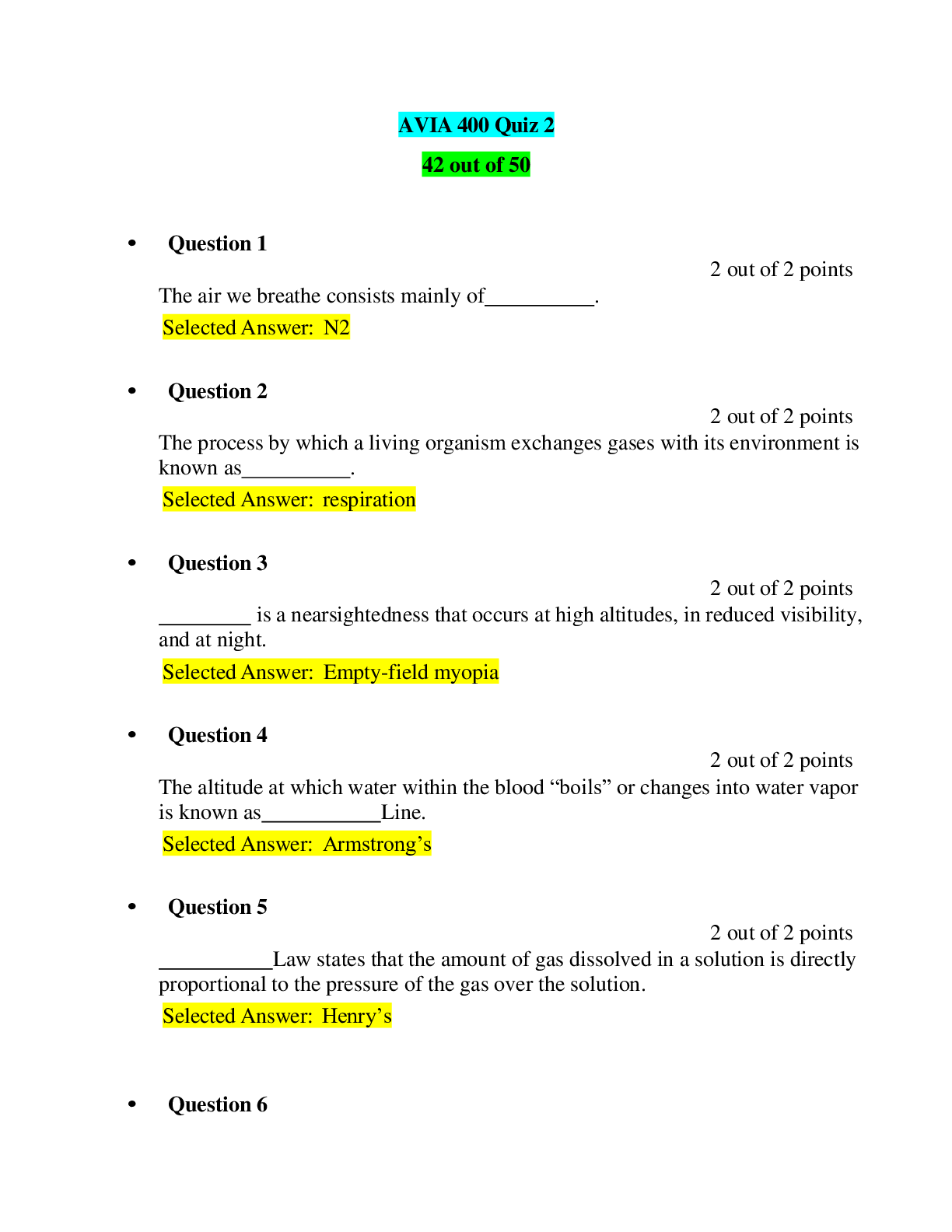

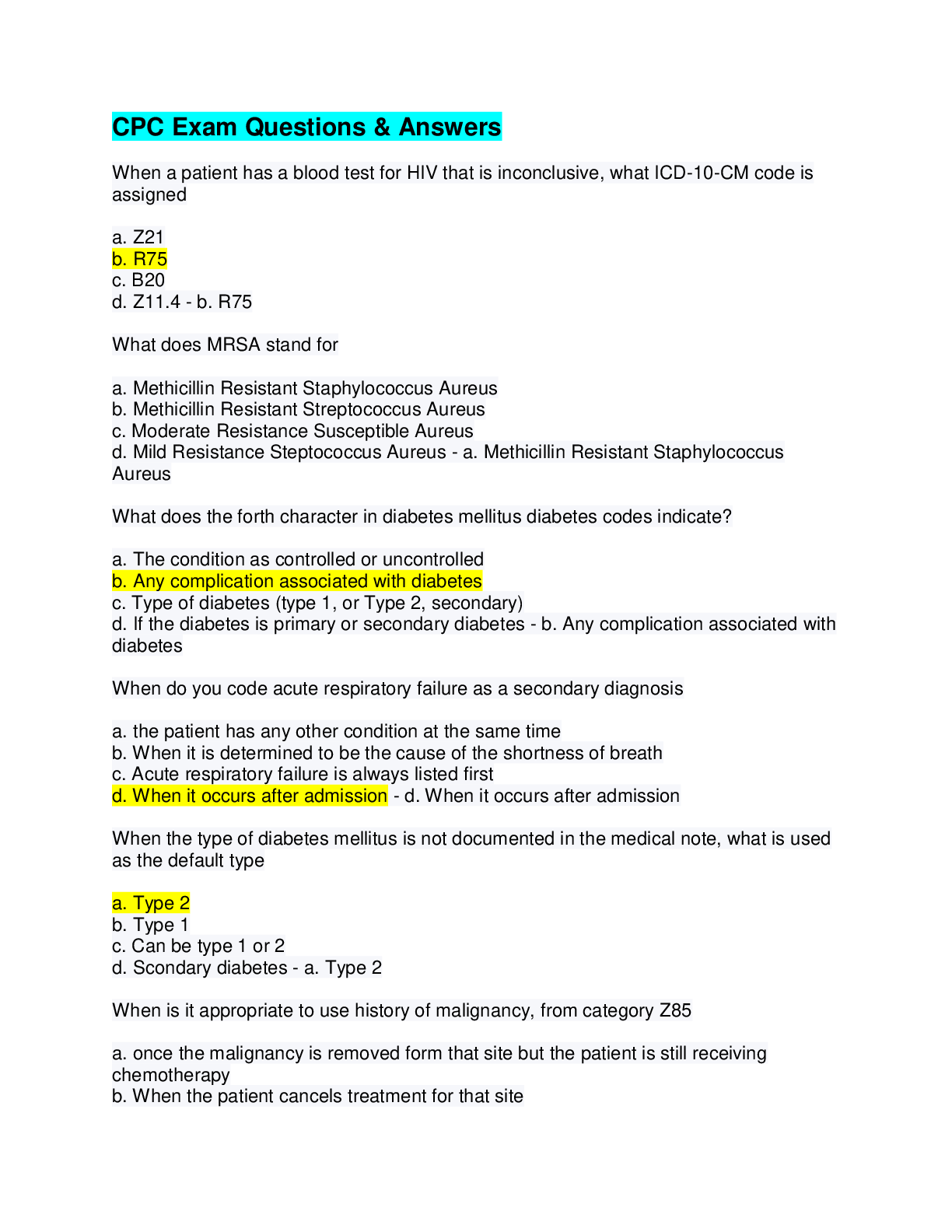
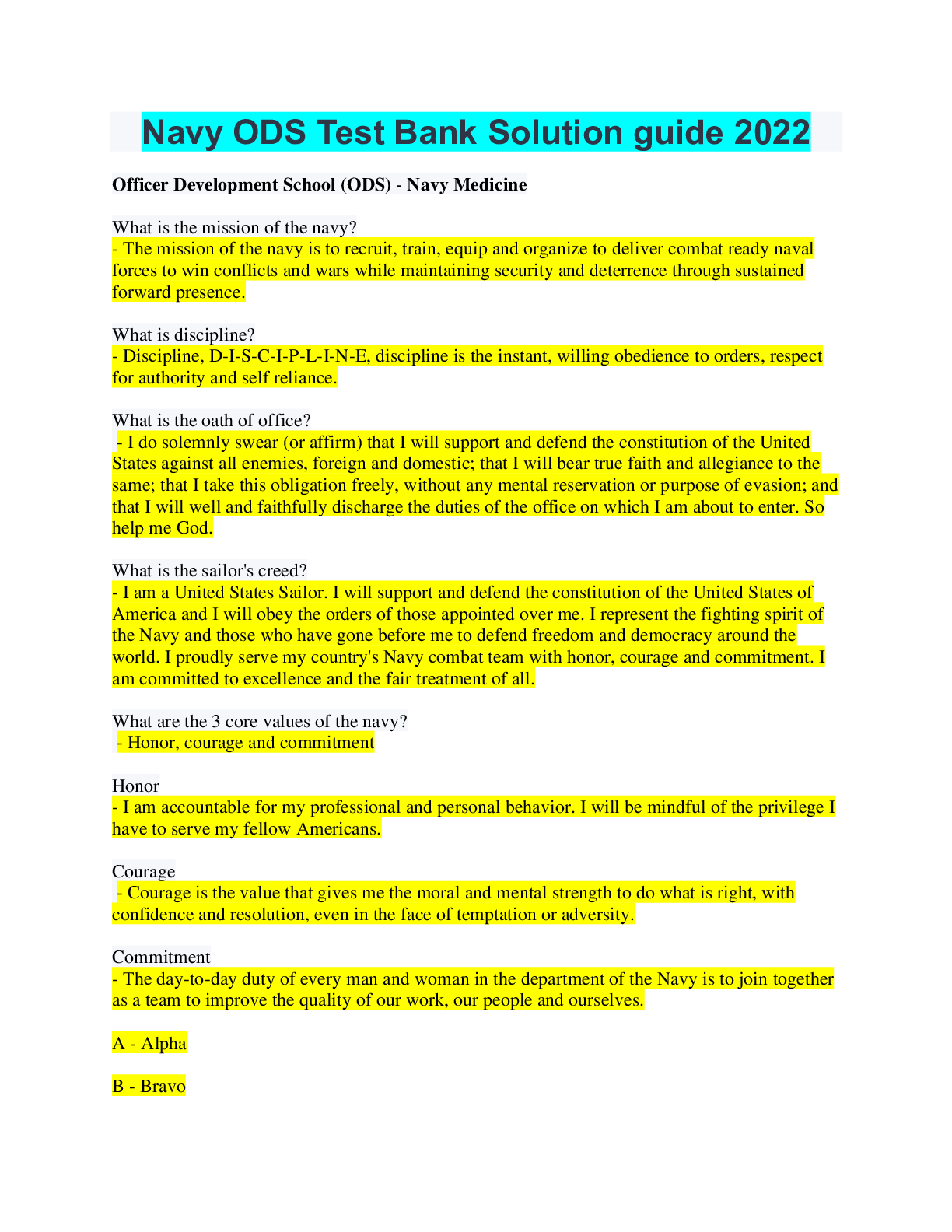



 Summer 2022.png)



.png)
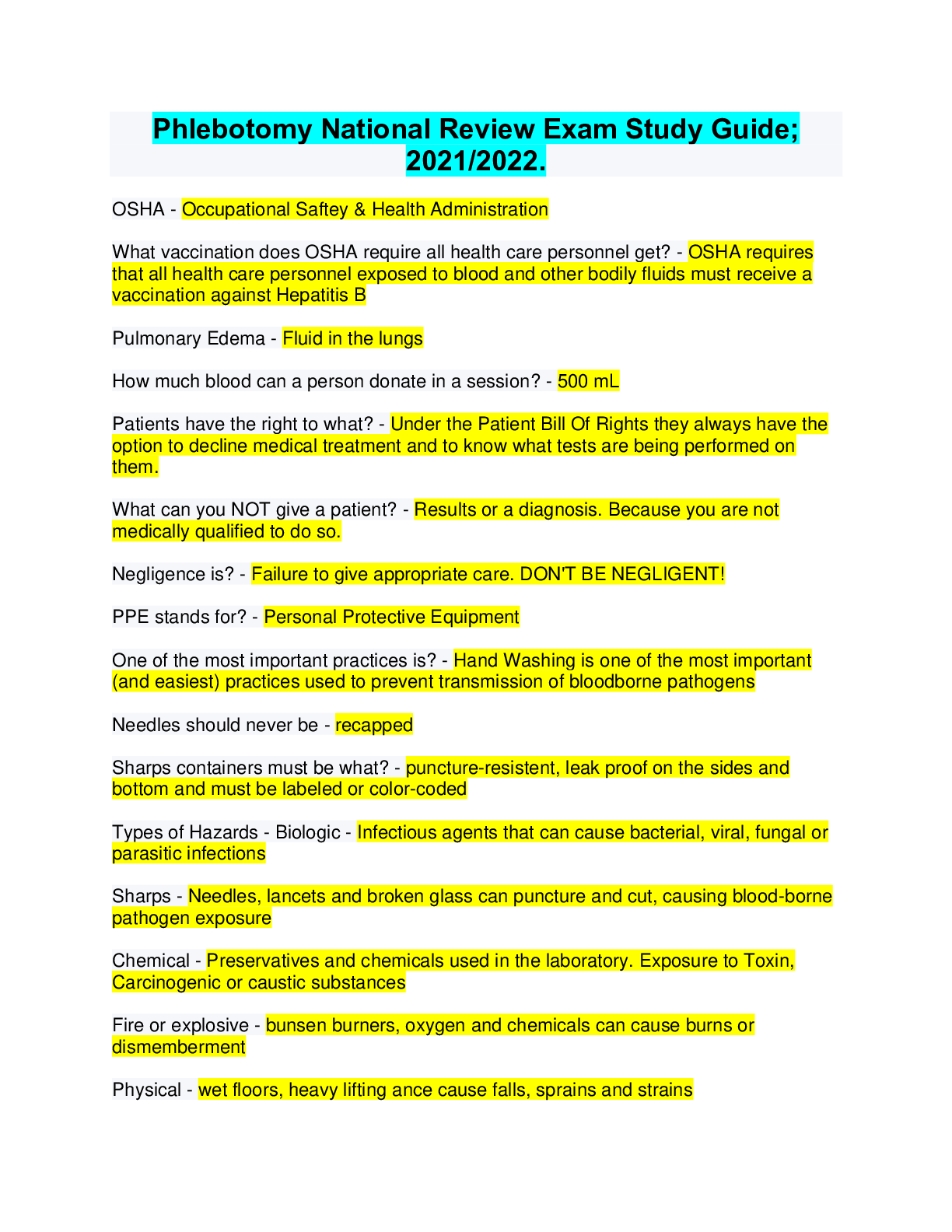


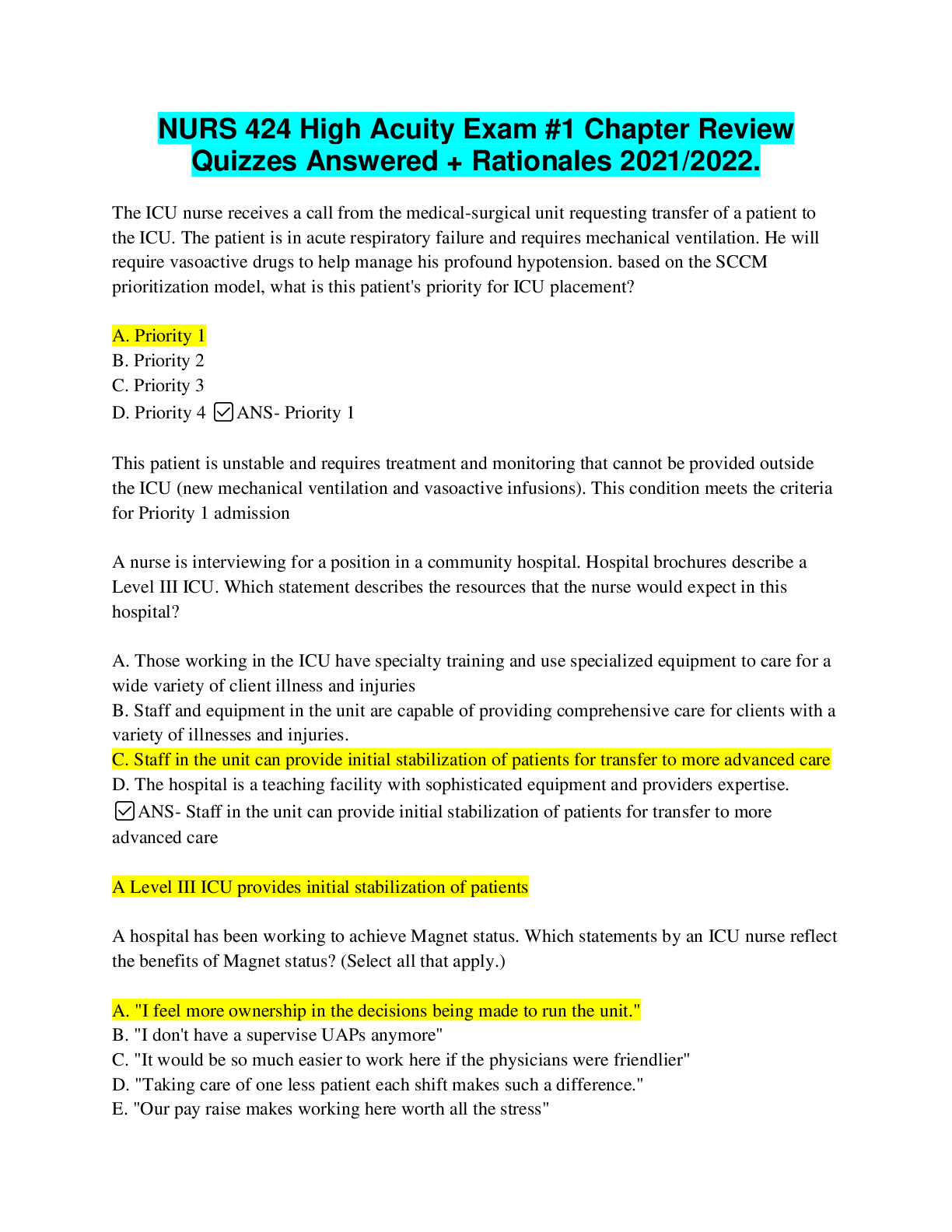
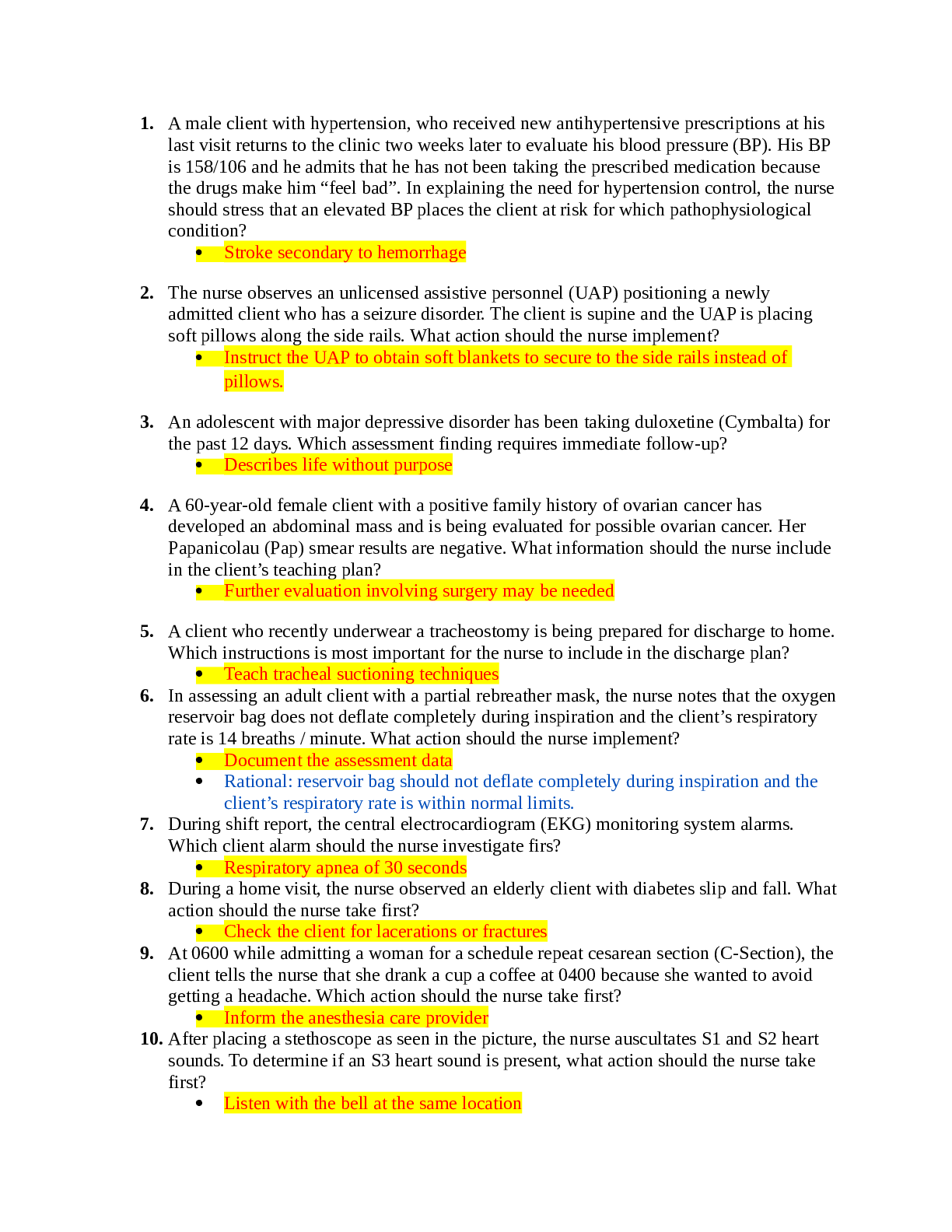

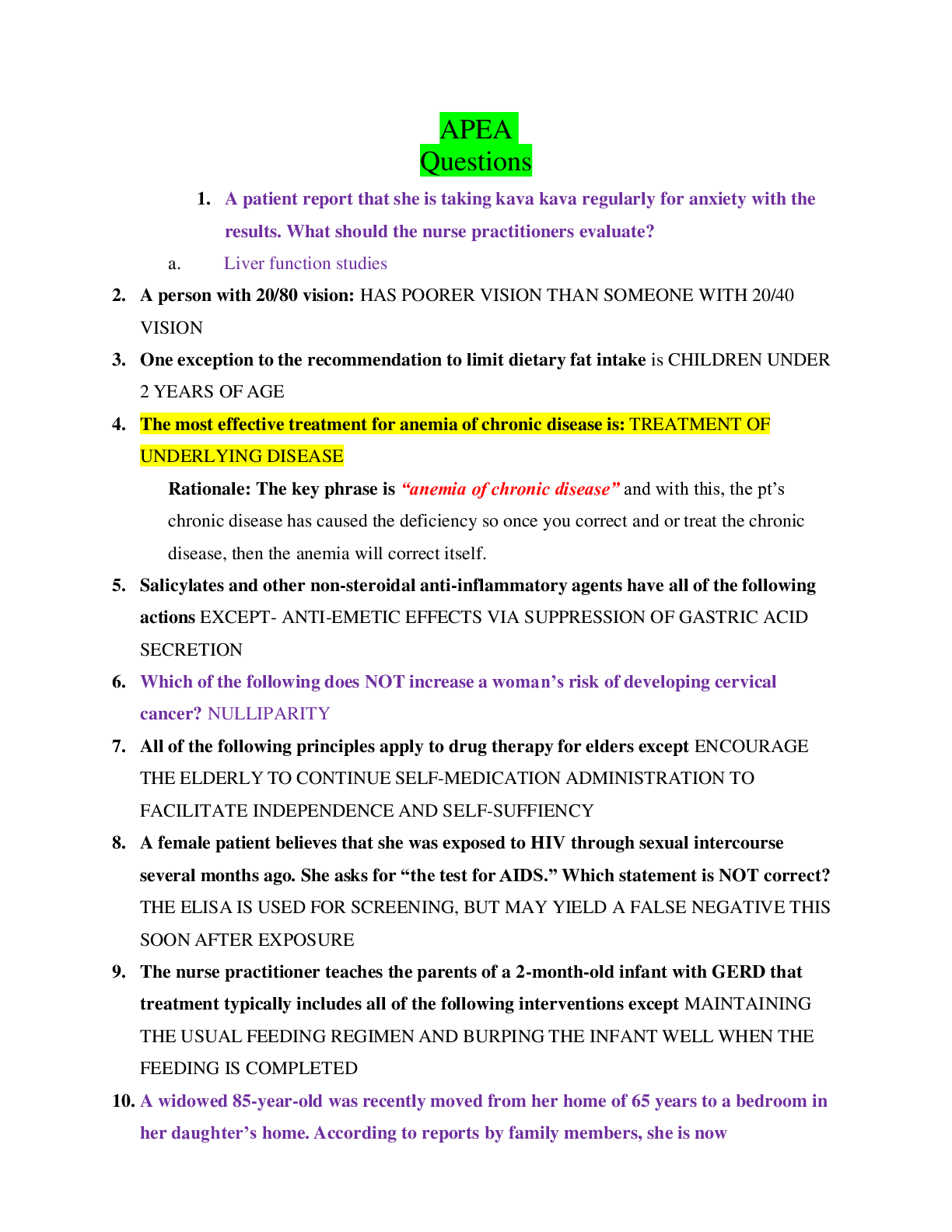




.png)

.png)




.png)
.png)

.png)



